|
Video: from ape man to neanderthaler (BBC)
LEARN TO RECOGNIZE & UNDERSTAND THE MOST IMPORTANT LINES IN THE PALM OF YOUR HANDS! The evolution of the human hand has been studied from various perspectives, including physicians and anthropologists. An often recommended source concerns the work titled 'Hands' by physician John Napier, who has become famous for the identification of the two typical human handgrips: the 'precision grip' and the 'power grip'. Napier (1980, p.31) wrote about the hand lines: "The infinite variety of primary and subsidiary flexure lines is a source of great satisfaction to professional palmists whose living is thereby guaranteed. Although there is no scientific support for the idea that palmar creases have any psychic or predictive meaning, it is well known that hands show evidence of occupation, disease, and to some extend temperament and personality - quite an adequate battery of information for the astute palmist to build up a pretty impressive augury." Napier also devoted a full chapter to the topic 'Evolution of the hand'. Napier describes with the classification of primate hands (find more details in the section primatology) and human fosile hands, how in evolution the 'foot-hand' - e.g. used for knuckle walk/fist walk - became a 'true hand' - e.g. used for prehensility: grasping/holding. This evolutionary development was featured with significant changes in the anatomy... and the motorics of the hand! An important figure in the history of medical science was the Scottish surgeon John Hunter, who turned the attention of science from the structure of the hand to the function. - John Hunter, Scottish surgeon (1728-1793) - How about the evolution of the lines the palm of our hands? The following Youtube video - titled 'Evolution of the human hand' - displays a detailed picture of what modern science knows (e.g. by following Darwin's evolution theory) about how the structure of the human hand changed during the last 1.8 million years: NOTICE: The pictures in the video of the 'early' humanoid hands are based on typical hand characteristics in 'old world monkeys', so these are not directly based on human hand fosiles. The video demonstrates how the 'early' humanoid hands (and primates) are typically featured with 3 or more 'complete transverse creases' (multiple simian lines), which are positioned horizontal in the hand + two major vertical lines. While at the end of the video displays a typical human hand featured with only 2 curved, oblique positioned 'primary palmar creases' (heart line and head line) + one major vertical line (life line). More details about the evolution of other features of the human hand are presented at: Hands, evolution & the mystery of the five fingers. In the perspective of the evolution of the human hand it might also be interesting to take a closer look at the oldest known human hand fosiles. Featuring with the cases of the 'early humans', the 'neanderthals', and 'Ardi' - which is known as the oldest humanoid fosile. • The hands of early hominids (30.000 years old): Dr. Wesley Niewoehner, from the University of New Mexico, described in 1991 that the hands of early hominids (see the example below) were better suited to using sophisticated tools compared with Neanderthals. 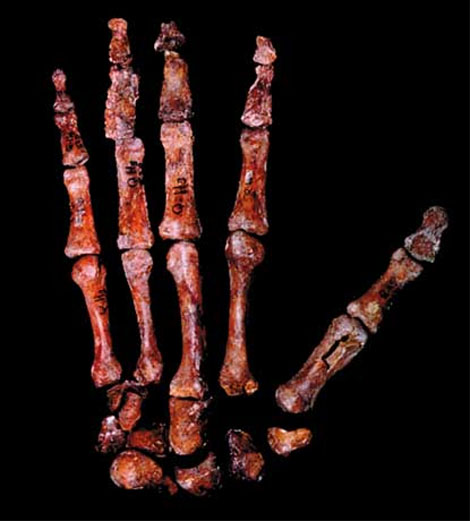
• The hands of Neanderthals (100.000 years old): From 1957-1961 nine Neanderthal sceletons were discovered in Shanidar Cave in northern Iraq. For one of the sceletons, Shanidar 4 (about 70.000 years old), almost the complete hand was found - see the photo below: 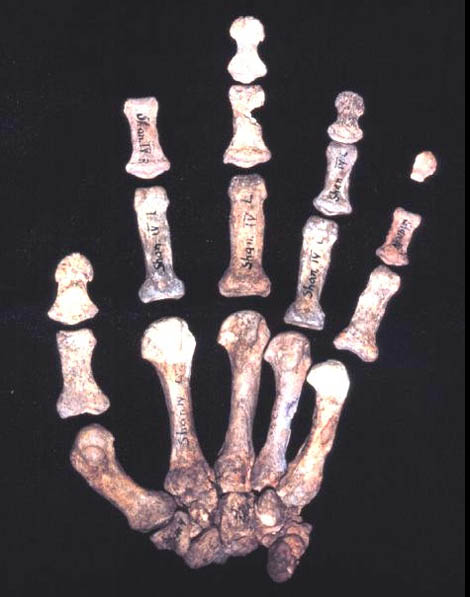
Since 1933 twelve Neanderthal sceletons were discovered in Skhul Cave in Israel. For one of the sceletons, Quafzeh 9 (about 93.000 years old), almost the complete hand was found - see the photo below: 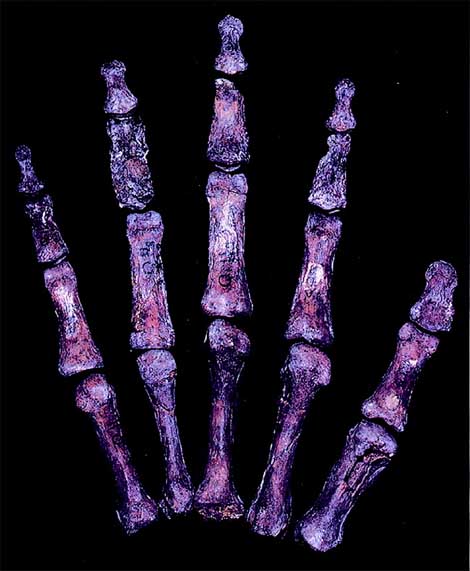
• The hand of 'Ardi' (4.4 million years old): The case of 'Ardi' (a.k.a. 'Ardipithecus ramidus') is today known as the oldest hominid fosile, which became public news in 2009: about 45% of the skeleton has been found, after the first pieces of the palm had been found in 1994 in Etiopia. Ardi's hands are featured with a large and well-muscled opposable thumb. Her wrists were flexible like ours, not stiff like those of chimpanzees and gorillas, which often support their heavy upper bodies whilst 'walking' on their knuckles. Ardi lacked the powerful upper torso and stiff wrists needed to swing from branch to branch as easily as modern apes but could easily cling to trees with her hands and feet suggesting that Ardipithecus had to be a careful climber and walked or rested on top of branches placing weight as necessary on the palms of its hands. Ardi's hand fosiles are displayed in the picture below - unfortunately there is no specified info about the characterstics hand lines, but they are featured in an artist's representation of how 'Ardi' may have looked like, see the 2nd picture below - NOTICE: in this piece of art is Ardi's hand featured with multiple horizontal lines, just like the lines in the hands of human apes. But contrary to human apes (other hominidae), scientists discovered that Ardi likely walked upright, on two legs ... just like us! 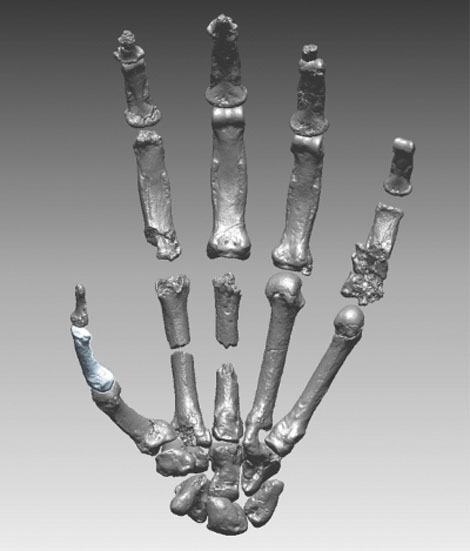
  Before the discovery of 'Ardi', 'Lucy' (discovered in 1974) was known as the oldest human-like fosile (only a few of her hand bones have been found) - though in 2006 another older 'baby' fossile (skull) had been found, named 'Selam', who was nicknamed "Lucy's baby". The latest important human hand fosile discovery was reported only one month ago in South Africa (Malapa): 2 skeletons of Australopithecus sediba (MH1, an adolescent boy and MH2, an adult female) - who probably lived about 2 million years ago. Finally, this summary is ended with the case of 'Ida' (reported in 2009) - a 47-million-year-old lemure like primate that had opposable thumbs like humans, fingernails instead of claws and hands that can grasp things. 
In order to understand the nature of the most common lines in the human hand more properly you can now take a look at an overview of the most common hand lines in the human hand today! ...more. 2D:4D DIGIT RATIO IN PRIMATES During the past decade scientists have started studying social behavior in primates & human ancestors via finger length ratios. Last year (november 2009) British researchers reported how finger length in primates is linked with social behavior. Exactly one year later, scientists from the universities of Liverpool, Oxford, Southampton and Calgary have now as well presented their findings on finger lengths studies in our distant cousins the Neanderthal! Guess what? The fossil finger lengths indicate that the early human, Neanderthal and early apes all had longer ring fingers - indicating they had been reared in a hormone-rich social environment. Dr Susanne Shultz, from the Institute of Cognitive and Evolutionary Anthropology at the University of Oxford explains: "Social behaviours are notoriously difficult to identify in the fossil record. Developing novel approaches, such as finger ratios, can help inform the current debate surrounding the social systems of the earliest human ancestors." Emma Nelson, from the University of Liverpool's School of Archaeology, Classics and Egyptology, described: "We have shown that promiscuous primate species have low index to ring finger ratios, while monogamous species have high ratios." In other words: results from finger length studies in various species, point out that finger length does provide a clue about sexual activity. NOTICE: These results describe the differences among various species - but the size of the results indicates that these insights can not (yet?) be applied on human individuals!! And we can only wonder about the question... could hand lines provide a likewise clue? 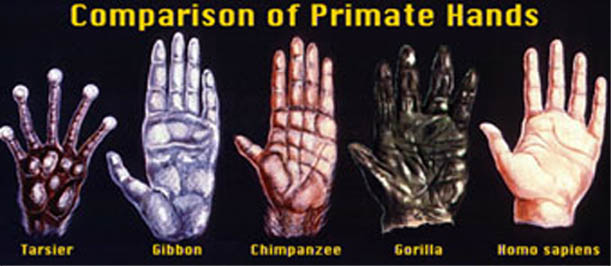
|
